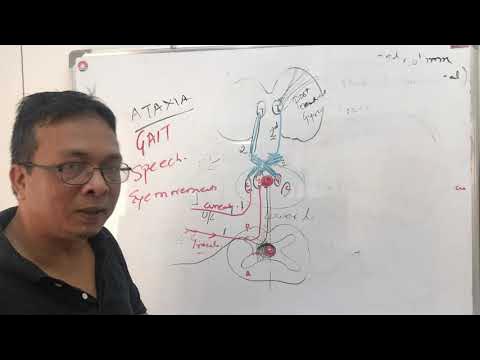Neurology – Ataxia (Gait) – By Wendy Stewart M.D.
Summary
TLDRAtaxia, a condition affecting body movement control, can be categorized into vestibular, cerebellar, and sensory ataxia. Vestibular issues cause vertigo and unsteadiness, often due to drugs or alcohol, with Meniere's disease a notable cause. Cerebellar ataxia impacts limb movements and gait, presenting as 'drunk-like' behavior, and can stem from various causes like strokes, inflammation, or hereditary disorders. Sensory ataxia, linked to proprioception, leads to an inability to stand with eyes closed (Romberg sign) and is often due to inflammation, vitamin deficiencies, or inherited conditions.
Takeaways
- 🧠 Ataxia refers to the loss of control over body movements, which can affect various parts of the body.
- 🌀 Vestibular system issues lead to disequilibrium and unsteadiness, with vertigo, nausea, and vomiting being common symptoms.
- 🍺 Drugs and alcohol are frequent causes of vestibular ataxia, while Meniere's disease is a specific condition to consider for unilateral issues.
- 🏓 The cerebellum plays a crucial role in body movement control, with different regions affecting trunk, gait, and limb movements.
- 🚶♂️ Truncal or gait ataxia is characterized by a wide-based gait and can make patients appear 'drunk'.
- 🤚 Cerebellar hemisphere lesions cause appendicular ataxia, affecting voluntary limb movements and leading to dysmetria and dysdiadochokinesia.
- 🗣️ Speech can be impacted by cerebellar issues, manifesting as variations in intensity and slurred words.
- 👁️🗨️ The flocculonodular lobe, or vestibulocerebellum, is responsible for postural stability and eye movement control.
- 🩸 Cerebellar ataxia can stem from various causes including vascular issues, inflammation, demyelination, tumors, infections, and hereditary disorders.
- 🦿 Sensory ataxia is linked to proprioceptive problems, causing difficulty standing with eyes closed (Romberg sign) and navigating in the dark.
- 💊 Conditions affecting sensory nerves can be due to inflammation, demyelination, vitamin deficiencies, infections, and inherited disorders.
Q & A
What is ataxia?
-Ataxia is a condition characterized by the loss of control over body movements, which can affect various parts of the body including the trunk, limbs, or one side.
What are the common causes of ataxia related to the vestibular system?
-Drugs and alcohol are the most common causes of vestibular ataxia. Meniere's disease is also important to consider if the ataxia is unilateral.
How does a problem with the cerebellum manifest in ataxia?
-Cerebellar ataxia can manifest as truncal or gait ataxia with a wide-based gait, or as appendicular ataxia affecting voluntary limb movements, leading to difficulties in tasks like finger-nose testing and rapid alternating movements.
What is the role of the vermis in cerebellar ataxia?
-The vermis is a midline structure in the cerebellum. Lesions affecting the area just lateral to and including the vermis result in truncal or gait ataxia.
What are the symptoms of appendicular ataxia?
-Appendicular ataxia symptoms include problems with voluntary limb movements, difficulty judging distances (dysmetria), and an inability to maintain the rhythm or amplitude of movements (dysdiadochokinesia).
How can the flocculonodular lobe affect ataxia?
-The flocculonodular lobe, also known as the vestibulocerebellum, when affected, can result in postural instability and impaired eye movement control.
What are some potential causes of cerebellar ataxia?
-Cerebellar ataxia can result from vascular lesions like stroke or hemorrhage, inflammation, demyelination, tumors, infections, hereditary disorders, or due to drugs or alcohol.
What is sensory ataxia and how is it related to proprioception?
-Sensory ataxia is a problem with proprioception, where lesions affecting the sensory pathways result in an inability to stand with eyes closed (Romberg sign) and difficulty in placing feet while walking.
What are some causes of sensory ataxia?
-Causes of sensory ataxia can include inflammation, demyelination, vitamin deficiencies, infections, and inherited disorders.
How does the Romberg sign relate to ataxia?
-The Romberg sign is indicative of sensory ataxia, where a patient is unable to stand with their eyes closed due to impaired proprioception.
What challenges do patients with sensory ataxia face while walking in the dark?
-Patients with sensory ataxia often stumble or walk heavily in the dark as they lack the visual input to assist with their gait and have impaired proprioception.
Outlines

هذا القسم متوفر فقط للمشتركين. يرجى الترقية للوصول إلى هذه الميزة.
قم بالترقية الآنMindmap

هذا القسم متوفر فقط للمشتركين. يرجى الترقية للوصول إلى هذه الميزة.
قم بالترقية الآنKeywords

هذا القسم متوفر فقط للمشتركين. يرجى الترقية للوصول إلى هذه الميزة.
قم بالترقية الآنHighlights

هذا القسم متوفر فقط للمشتركين. يرجى الترقية للوصول إلى هذه الميزة.
قم بالترقية الآنTranscripts

هذا القسم متوفر فقط للمشتركين. يرجى الترقية للوصول إلى هذه الميزة.
قم بالترقية الآنتصفح المزيد من مقاطع الفيديو ذات الصلة
5.0 / 5 (0 votes)






